Embedded Programming
This assignment focuses on documenting my knowledge gained in Embedded Programming. It covers fundamental topics such as architectures, memory, peripherals, word size, various microcontroller families, and packaging, as well as my experiences working on a group project. comparing performance and development workflows for different architectures, along with an individual assignment and group assignment.
Group Assignment
Understanding the data sheets of microcontrollers
Studying the datasheet for the XIAO RP2040 Development Board for understanding its functionalities and specifications thoroughly. This document contains detailed technical information, such as electrical characteristics, pinout diagrams, communication protocols, and recommended operating conditions. With this knowledge, we can design, program, and troubleshoot projects effectively. The datasheet guides us to make informed decisions regarding hardware connections, firmware development, and optimization strategies.
Compare the performance and development workflows for other architectures(acco)
In this section, we evaluate various microcontrollers, including our chosen RP2040, by examining key factors such as microcontroller type, core specifications, architecture, operating voltage, and digital pin count. This analysis provides insight into how the RP2040 compares to other microcontroller options and highlights its unique features. Further information can be found in the Group Assignment. Please find group assignment link Click Here
Individual Assignment
write a program for a microcontroller development board.
Embedded System Programming
An embedded system is a specialized computer system made up of a processor, memory, and input/output peripherals, designed to perform a specific function within a broader mechanical or electronic setup. It is integrated into a complete device that typically consists of electrical or electronic components along with mechanical elements. Because an embedded system typically controls physical operations of the machine that it is embedded within, it often has real-time computing constraints. Embedded systems control many devices in common use. For more information click on link Resource Link
Embedded Systems
Embedded Systems Classification
| Type | Characteristics |
|---|---|
| Mobile Embedded Systems | Small and portable systems, like digital cameras. |
| Networked Embedded Systems | Connected to a network, interact with other systems, such as home security systems or point of sale (POS) systems. |
| Standalone Embedded Systems | Operate independently and perform specialized tasks, like calculators or MP3 players. |
| Real-time Embedded Systems | Provide outputs within defined time intervals, crucial for time-sensitive tasks like traffic control systems. |
Embedded Systems Performance Requirements
| Performance Level | Microcontroller Type |
|---|---|
| Small-scale Embedded Systems | Simple microcontrollers, typically 8-bit. |
| Medium-scale Embedded Systems | Larger microcontrollers (16-32 bit) allowing multiple connections. |
| Sophisticated-scale Embedded Systems | Complex algorithms, software, and hardware, often requiring configurable processors and programmable logic arrays. |
Common Software Architectures for Embedded Systems
| Architecture Type | Description |
|---|---|
| Simple Control Loops | Manage hardware and programming with subroutine calls. |
| Interrupt Controlled Systems | Main and secondary loops where interruptions trigger tasks. |
| Cooperative Multitasking | Simple control loop within an API. |
| Preemptive Multitasking/Multithreading | Used with real-time operating systems (RTOS), featuring synchronization and task-switching strategies. |
Embedded Systems Applications
| Application | Description |
|---|---|
| Telecommunications | Telephone switches, cell phones, routers, network bridges |
| Consumer Electronics | MP3 players, television sets, mobile phones, video game consoles, digital cameras, GPS receivers, printers |
| Household Appliances | Microwave ovens, washing machines, dishwashers, HVAC systems, home automation devices |
| Transportation | Aircraft avionics, spacecraft systems, electric motors, automotive safety systems |
| Medical Equipment | Monitoring equipment, medical imaging devices (PET, SPECT, CT, MRI) |
| Aerospace and Defense | Safety-critical systems, fire safety systems, security systems |
| Wireless Sensor Networking | Motes, networked wireless sensors |
Basic Structure of an Embedded System
img from google
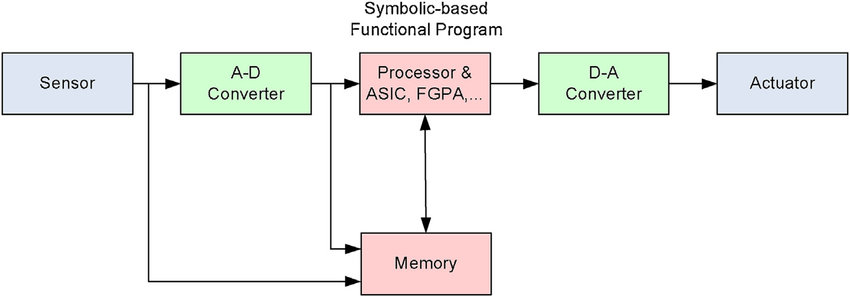
Sensor System Components
| Component | Description |
|---|---|
| Sensor | It measures the physical quantity and converts it to an electrical signal which can be read by an observer or by any electronic instrument like an A2D converter. A sensor stores the measured quantity to the memory. |
| A-D Converter | An analog-to-digital converter converts the analog signal sent by the sensor into a digital signal. |
| Processor & ASICs | Processors process the data to measure the output and store it to the memory. |
| D-A Converter | A digital-to-analog converter converts the digital data fed by the processor to analog data. |
| Actuator | An actuator compares the output given by the D-A Converter to the actual (expected) output stored in it and stores the approved output. |
For more info refer this site Resource Link
Architecture
Von Neumann Architecture:
The Von Neumann architecture, named after the Hungarian-American mathematician and computer scientist John von Neumann, represents a fundamental design concept for modern computers. In this architecture, both instructions and data are stored in the same memory space, and a single bus is used to transfer both instructions and data between the CPU and memory.
In a Von Neumann architecture, the CPU performs operations sequentially, meaning it can only execute one instruction at a time. This limitation arises because the CPU shares a common bus for fetching instructions from memory and accessing data. As a result, if the CPU is fetching an instruction from memory, it cannot simultaneously perform a data operation, such as reading or writing data.
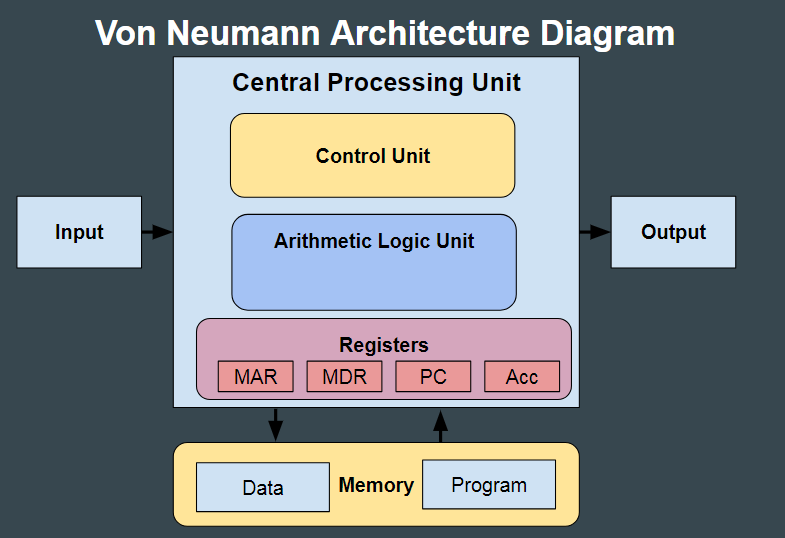
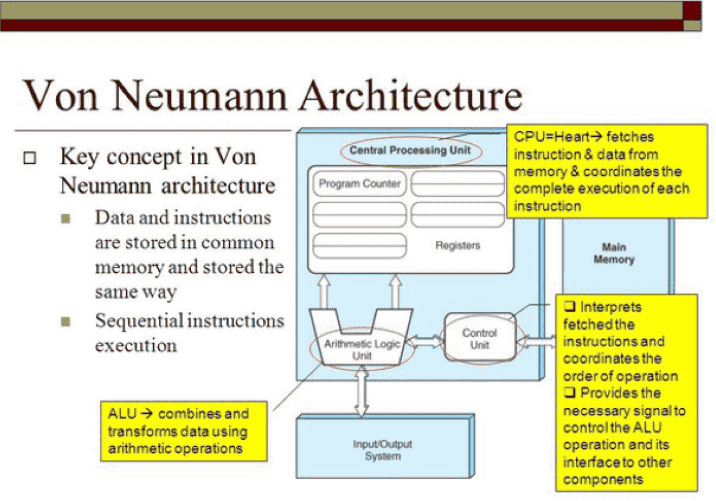
Harvard Architecture:
In a typical computer using Von Neumann architecture, instructions and data are stored together in the same memory. This means that the same pathways, called buses, are used to fetch both instructions and data. Because of this setup, the CPU can't perform both tasks simultaneously—reading instructions and accessing or modifying data—at the same time.
To address this limitation, Harvard Architecture was developed. In Harvard Architecture, there are separate storage areas and pathways (buses) for instructions and data. This means that the CPU can access instructions and read or write data at the same time without any conflict or slowdown. This separation of pathways helps overcome the bottleneck that exists in von Neumann's Architecture, where the CPU has to wait for one operation to finish before it can start another.
So, the main advantage of Harvard Architecture is that it allows the CPU to perform multiple tasks concurrently, leading to potentially faster and more efficient operation.For more information Resource Link
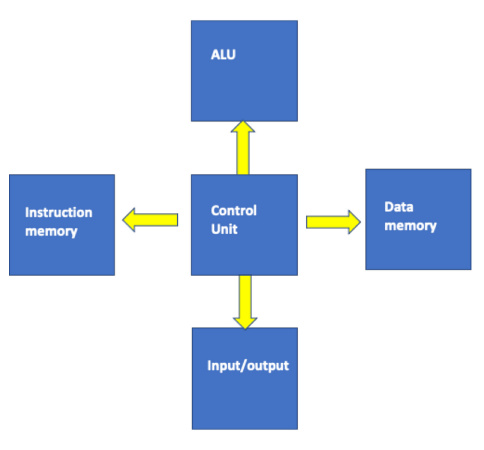
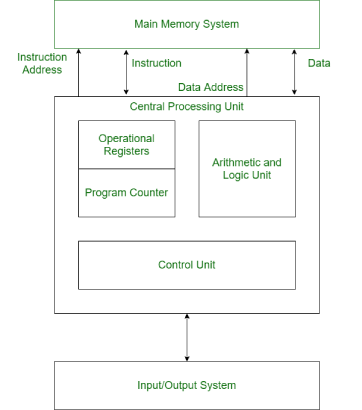
Difference Between Von Neumann and Harvard Architecture
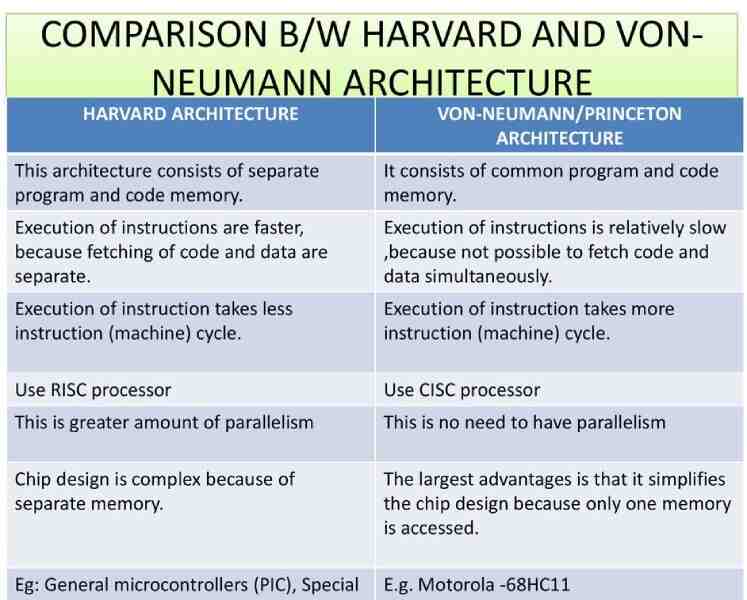
RISC AND CISC
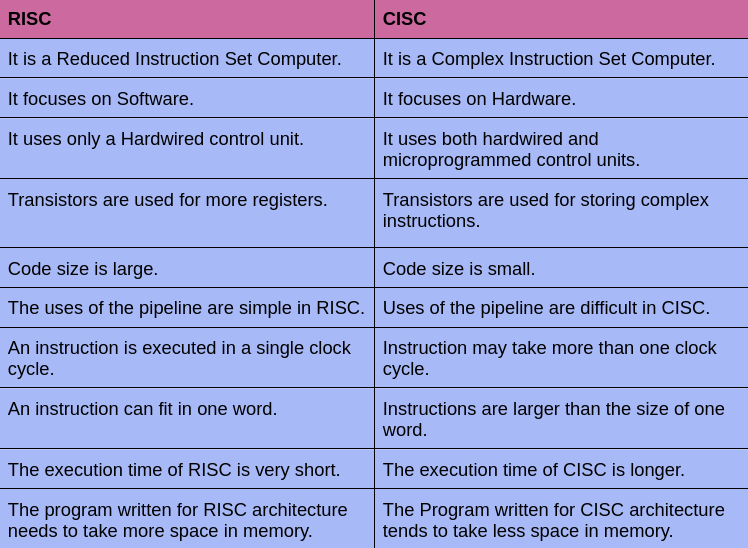
Microprocessor
A Microprocessor is an important part of a computer architecture without which we will not be able to perform anything on our computer. A microprocessor is like the brain of a computer. It's a tiny chip that follows instructions to do math and logic tasks, producing outcomes. It fetches instructions, figures out what they mean, does what they say, and gives results.
Since I don't have an electronics background, I am eager to learn more about microprocessors so
I found valuable information in the resource link I have attached.Resource Link1
Resource Link2
Basics of Microprocessor
A Microprocessor takes a bunch of instructions in machine language and executes them, telling the processor what it has to do.
A microprocessor carries out three fundamental functions when processing instructions. It conducts essential operations such
as addition, subtraction, multiplication, division, and various logical functions through its Arithmetic and Logical Unit (ALU).
Additionally, data within the microprocessor can transfer between different locations. The microprocessor utilizes a Program
Counter (PC) register, which keeps track of the address of the next instruction, allowing it to move from one location
to another based on the value stored in the PC and takes decisions.
I took assistance to study the microprocessor from the provided website.Resource Link
A regular microprocessor structure looks like this.

Types of Microprocessor
A microprocessor is a type of computer processor commonly used in contemporary personal computers, smartphones, and various electronic devices. It is a central processing unit (CPU) that performs most of the processing tasks in a computer system. The microprocessor is a key component of a computer, as it controls the fetching, decoding, and execution of instructions that are stored in memory.
Types of Processors
| Processor Type | Description |
|---|---|
| Vector Processor | A type of CPU designed to perform mathematical operations on arrays of data more efficiently than scalar processors. |
| Array Processor or SIMD Processor | Designed for vector computations; employs multiple processing elements to operate in parallel. |
| Scalar Processor | Executes scalar data, can be simple or powerful depending on capabilities. |
| RISC and CISC Processor | Two approaches to CPU design - RISC has a smaller, simpler instruction set while CISC has a larger and more complex one. |
| Digital Signal Processor | Specialized microprocessor for high-speed mathematical operations on digital signals. |
| Symbolic Processor | Designed for symbolic computation, manipulation of mathematical expressions using symbolic logic. |
| Graphics Processor | Specialized microprocessor for accelerating rendering of 2D and 3D graphics. |